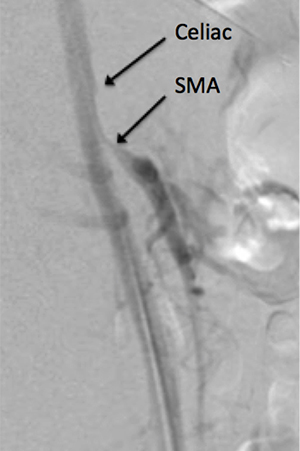Aorta to superior mesenteric artery bypass in a 14-year-old with elastin arteriopathy
Julia F. Chen, MD1, Cassius Iyad Ochoa Chaar, MD, MS1, Kristine Orion, MD1, Michael Caty, MD1, Timur Sarac, MD2, Jonathan Cardella, MD1.
1Yale New Haven Hospital, New Haven, CT, USA, 2Ohio State University, Columbus, OH, USA.
DEMOGRAPHICS: This is a 14-year-old female with medical history significant for elastin arteriopathy, von Willebrandís disease and surgical history significant for repair of supravalvular aortic stenosis, hypoplastic aortic arch andpulmonary stenosis.
HISTORY: The patient presented to the vascular surgery service for evaluation of four weeks of postprandial abdominal pain and MRA demonstrating both celiac and SMA narrowing, concerning for chronic mesenteric ischemia. She did not report any significant weight loss. A diagnostic angiogram revealed >70% stenosis of the superior mesenteric and celiac arteries with distal reconstitution (figure). She was also noted to have left renal stenosis and was on one hypertensive medication.
PLAN: Multidisciplinary review of the case resulted in the decision for an open surgical approach. Endovascular options were considered, but due to the patientís age and the lack of literature and experience regarding mesenteric angioplasty in the pediatric population, it was felt that an open approach would be most durable. The patient was taken to the operating room and a midline transabdominal incision was made. She underwent end-to-side bypass grafting from the supraceliac aorta to the superior mesenteric artery, followed by a jump-graft to the right hepatic artery utilizing reversed greater saphenous vein. There were no complications; she has been seen in clinic for a 3-month follow-up and is asymptomatic.
DISCUSSION: Aorto-mesenteric bypass in patients with elastin arteriopathy has not been previously been reported in either the pediatric or adult populations. Chronic mesenteric ischemia is rare in the pediatric population, but literature review demonstrates that regardless of cause, it is almost always treated with open mesenteric bypass. Elastin arteriopathy is caused by a genetic mutation and often associated with Williams syndrome, which was not the case in our patient. Furthermore, its hallmark defect is supravalvular aortic stenosis; hypoplastic and/or stenotic visceral and renal arteries are frequently part of the general descriptors used to define the disease, but there are no previous case reports of surgical treatment of mesenteric ischemia in this population. 
Back to 2019 Abstracts
